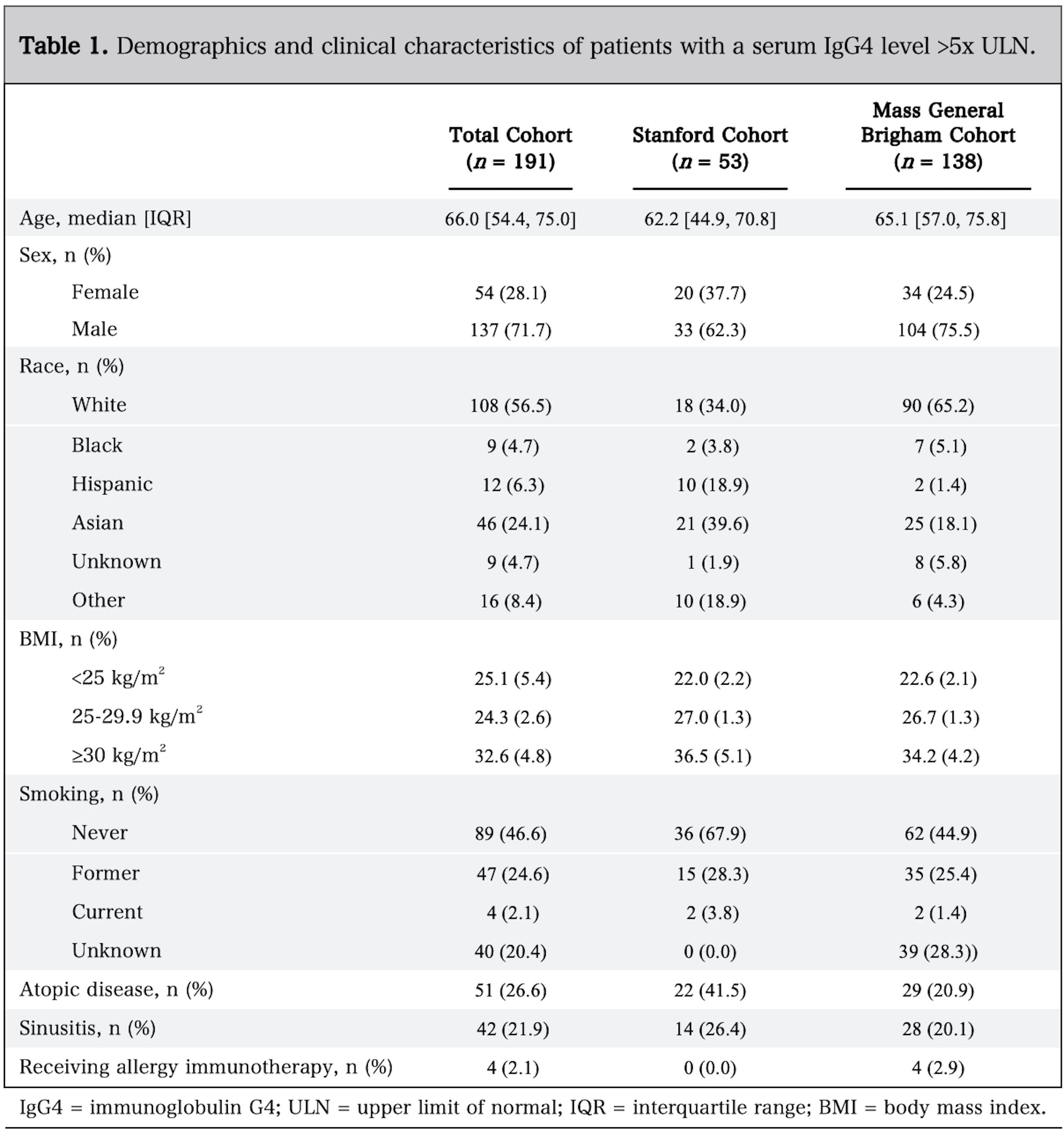Session Information
Date: Monday, November 8, 2021
Session Type: Poster Session C
Session Time: 8:30AM-10:30AM
Background/Purpose: Serum IgG4 concentrations are used as part of the evaluation for suspected IgG4-related disease (IgG4-RD), but the specificity of this test, especially at very high levels, remains uncertain. Indeed, the ACR/EULAR Classification Criteria for IgG4-RD place high weight on elevated serum IgG4 concentrations; of the 20 points required to be classified as IgG4-RD, 11 are assigned if the patient has an IgG4 concentration ≥ 5x the upper limit of normal (ULN).1 We sought to evaluate the association of very high serum IgG4 concentrations with a diagnosis of IgG4-RD.
Methods: The data warehouses at two large academic medical centers—Stanford University and Mass General Brigham—were queried for all IgG subclass test results. Patients with any serum IgG4 concentration ≥ 5x the ULN were included. Demographics, medical history, and other laboratory test results of interest were extracted from the electronic medical record of each patient. A diagnosis of IgG4-RD was determined using the ACR/EULAR Classification Criteria for IgG4-RD. The positive predictive value (PPV) of a serum IgG4 concentration ≥ 5x the ULN for the diagnosis of IgG4-RD was estimated. Other conditions associated with very high serum IgG4 concentrations, and specific features of the IgG4-RD patients, were characterized.
Results: Of 34,391 patients with serum IgG subclasses tested, 2,294 (7%) had an elevated serum IgG4 concentration, and 191 (0.6%) had an IgG4 concentration ≥ 5x the ULN. The combined cohort had a median age of 66 years, was predominately male (72%), and was racially diverse (Table 1). The PPV of an IgG4 concentration ≥ 5x the ULN for a diagnosis of definite (67%), probable (5%), or atypical (1%) IgG4-RD was 73%. The median [IQR] IgG4 concentration among patients with definite IgG4-RD (n = 128) was 1014.5 mg/dL [678.5, 1419.9] (Table 2). Other diseases associated with a very elevated serum IgG4 concentration included B cell lymphoma and leukemia, eosinophilic granulomatosis with polyangiitis and other hypereosinophilic syndromes, systemic lupus erythematosus, histiocytic disease, and systemic infections or post-infectious syndromes (Table 2). Among IgG4-RD patients with an IgG4 concentration ≥ 5x the ULN, the majority (82%) had multi-organ involvement, with the pancreas (50%), salivary glands (49%), lacrimal glands (33%), and kidneys (30%) being the most commonly involved organs (Table 3).
Conclusion: The majority of patients with a serum IgG4 concentration ≥ 5x the ULN in this study had IgG4-RD, with a PPV of 73% for IgG4-RD. These data support the significant weight placed on very elevated serum IgG4 in the IgG4-RD Classification Criteria. However, it is notable that 27% of patients with an IgG4 concentration ≥ 5x the ULN had no identifiable cause or an alternative diagnosis, underscoring the importance of the Classification Criteria’s entry and exclusion criteria when evaluating a patient with a very high IgG4 concentration for IgG4-RD. These findings highlight the broad differential to consider when evaluating a patient with a very high IgG4 concentration.
References:
1. Wallace ZS, Naden RP, Chari S, et al., Arthritis Rheumatol 72, 7-19 (2020).
To cite this abstract in AMA style:
Baker M, Cook C, Fu X, Perugino C, Stone J, Wallace Z. Disease Associations with Very High Serum IgG4 Concentrations: A Retrospective Multi-Center Study [abstract]. Arthritis Rheumatol. 2021; 73 (suppl 9). https://acrabstracts.org/abstract/disease-associations-with-very-high-serum-igg4-concentrations-a-retrospective-multi-center-study/. Accessed .« Back to ACR Convergence 2021
ACR Meeting Abstracts - https://acrabstracts.org/abstract/disease-associations-with-very-high-serum-igg4-concentrations-a-retrospective-multi-center-study/



